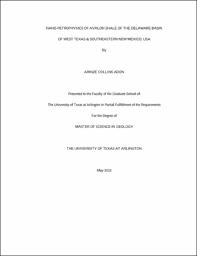| dc.description.abstract | The Avalon Shale is a Permian-aged stratum and represents a significant rock unit within the Bone Spring, of the Delaware basin of West Texas and Southeastern New Mexico. The Delaware Basin has witnessed increased drilling activities owing to the resurgence in the Permian basin, where organic-rich shales of the Wolfcamp, Avalon and tight Bone Spring Sands, are the primary targets. However, this boom in production has been constrained by low recovery from tight reservoirs. This problem has continued to attract attention because of the need to improve the reservoir performance of the Bone Spring wells.
To achieve this objective, a suite of experiments has successfully been performed on several samples from the Avalon Shale, and the First and Second Bone Spring Sands. Results indicate that the Avalon Shale has a moderate hydrocarbon generating potential, with sample AS 1AF-6342 having an S2 value of 4.76 mgHC/g, TOC value of 2.25%, Tmax value of 438oC, is oil prone and rich in type II/III kerogen (marine and terrestrial origin). Average TOC content across the Avalon shale is 1.1%, and 1% for the Second Bone Spring Sand. XRD results indicate the existence of five different lithofacies within the Avalon Shale and two among the Bone Spring Sands. The average porosity ranges from 0.2 to 6.7% for Avalon Shale, 4.9 to 8.1% for the First Bone Spring Sand, and 0.3 to 3% for the Second Bone Spring Sand. Absolute permeability is very low and relative permeability will be affected by the co-presence of oil and gas within the Avalon Shale. MICP results show that organic, intragranular, intergranular and microfracture pores, are common pore types found within the Avalon Shale, whereas inter-clay platelets, organic pores, intragranular, intergranular and microfractures are found in the Second Bone Spring Sand. Spontaneous imbibition results show that the Avalon Shale is moderately water-wet, intermediary water wet for First Bone Spring Sand and oil-wet for the Second Bone Spring Sand. Pore structure characteristics show that clay composition, compaction and the ratio of intragranular pores to microfractures greater than 1 µm, all affects porosity. The higher the microfracture-sized pores greater than 1 µm, the lower the porosity. in summary, targeting the source rock at 6342 feet for horizontal drilling will be ideal, as it has the optimal mineralogy to maintain a good fracture growth. Furthermore, the overlying rocks at 6328-6331 feet are porous, rich in quartz and will support a good fracture height. | |


